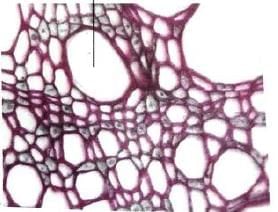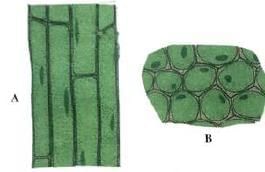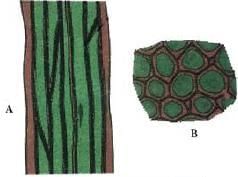Plant and Animal Tissues Chapter Notes | Biology Class 7 ICSE PDF Download
Introduction
This chapter explores the fascinating world of tissues in plants and animals, the building blocks that form organized structures in living organisms. It begins with the basic unit of life, the cell, and explains how cells group together to form tissues, organs, and organ systems, ultimately creating organisms. The chapter covers types of plant tissues, including meristematic and permanent tissues, and their roles in growth, support, and transport. It also describes animal tissues, such as epithelial, connective, muscular, and nervous tissues, highlighting their functions in protection, support, movement, and communication.
Tissues
- All multicellular organisms (animals and plants) start their life as a single cell (the fertilised egg or zygote).
- The fertilised egg divides repeatedly to produce thousands, millions or billions of cells (trillions in human body).
- Some cells form skin, some form bones, and still others form muscles, blood.
- A group of cells, which are similar in structure, and perform a specific function, form a tissue.
- For example, the surface cells of the skin form one tissue, the cells constituting muscle tissue contractile and constituting form one, or the green cells of a leaf or the stem and the wood forming cells of the stem constitute another.
Kinds of Tissues
The bodies of plants and animals consist of different types of tissues, each of which performs a specific function.
Plant Tissues
Plant tissues are divided into two main kinds: meristematic and permanent tissues.
Meristematic Tissues
- Composed of actively dividing cells.
- Their main job is to produce more cells for plant growth.
- Found at growing points like tips of roots, stems, and branches for length growth.
- Also responsible for growth in the thickness of stems.
- Characteristics of meristematic tissues:
- Cells are small.
- Cell walls are thin.
- Nuclei are large and noticeable.
- Cells have almost no vacuoles.
- Cells actively divide to add new cells.
Activity 1: To Study the Activity of Meristematic Tissue in a Plant
- Soak green gram (moong) seeds overnight in water.
- Place them on soaked cotton in a petri dish.
- After two or three days, observe white sprouts growing fast.
- The root tip contains meristematic tissues that aid growth.
Permanent (Non-Dividing) Tissues
- Form the bulk of the plant body and do not divide.
- Cells become specialized and remain the same throughout life.
- New cells from meristematic tissues grow, mature, and differentiate into permanent tissues.
- Two main types: simple permanent tissue and complex permanent tissue.
Simple Permanent Tissues
According to the function, the simple permanent tissues are of two types:
(i) Protective tissue
(ii) Supportive tissue.
Protective Tissue
- Consists of cells with thick walls.
- Found on the surface of roots, stems, and leaves.
- Example: Epidermis of leaves secretes a waxy, water-proof substance.
- Water drops do not stick to leaves due to this waxy layer.
Supporting Tissue
Three categories: parenchyma, collenchyma, and sclerenchyma.
Parenchyma:
- Made of large, thin-walled cells, usually with intercellular spaces.
- Living cells found in soft parts of plants.
- Store food material and provide temporary support.
- Potatoes are mainly parenchyma cells storing starch.
- Some parenchyma cells in leaves contain chlorophyll for food manufacture.

Collenchyma:
- Composed of living, elongated cells thick at the corners or edges.
- Found in leaf stalks and below the epidermis of stems.
- Helps support plant parts.

Sclerenchyma:
- Made of long, narrow, thick-walled, dead cells.
- Provides strength to plant parts.
- Found in stems and veins of leaves, mostly as fibers.

Comparison Between Parenchyma, Collenchyma, and Sclerenchyma
Parenchyma:
- Characteristics: Spherical, thin-walled cells with large intercellular spaces, living at maturity.
- Location: Found throughout the plant in every soft part.
- Function: Photosynthesis, respiration, food storage, buoyancy in aquatic plants.
Collenchyma:
- Characteristics: Elongated cells with unevenly thickened walls at edges, little intercellular spaces, living at maturity.
- Location: Found in petioles, veins of leaves, and young stems.
- Function: Provides flexible mechanical support to plant parts.
Sclerenchyma:
- Characteristics: Long, narrow, thick-walled cells, no intercellular spaces, dead at maturity.
- Location: Found in mature parts like wood, bark, etc.
- Function: Provides rigid mechanical and structural support to the plant.
Complex Permanent Tissues
- Also called conducting or vascular tissue.
- Provides a passage for transporting materials in the plant.
- Two types: xylem and phloem.
- Xylem:
- Made of thick-walled, tubular, often dead cells placed end-to-end.
- Partitions between cells dissolve to form long channels.
- Components: tracheids, vessels, xylem parenchyma, and xylem fibers.
- Transports water and minerals from roots upward to leaves.
- Water is used in photosynthesis or lost as vapor in transpiration.
- Old xylem forms wood and does not transport food.
- Phloem:
- Consists of tubular cells for upward and downward movement of food made in leaves.
- Components: sieve tubes, companion cells, phloem parenchyma, and phloem fibers.
Differences Between Xylem and Phloem
Xylem:
- Transports water and minerals from roots to other plant parts.
- Consists mainly of dead cells.
- Conduction is unidirectional, only upwards from roots.
Phloem:
- Conducts food made in leaves to other plant parts.
- Consists mainly of living cells.
- Conduction is bidirectional, both upwards and downwards from leaves.
Activity 2: To Study Different Types of Plant Tissues
- Ask your teacher for prepared slides of plant tissues.
- Place each slide on the microscope and let the teacher focus it.
- Parenchyma:
- Observe large, thin-walled cells with a large vacuole.
- Copy the diagram in your notebook and label the nucleus.
- Found in softer parts like pith of roots and stems.
- Collenchyma:
- Observe elongated cells with thickened walls at corners.
- Copy the diagram in your notebook and label the thickenings.
- Found in leaf stalks and below the epidermis of stems.
- Sclerenchyma:
- Look at long, narrow cells like cotton fiber.
- Note they are thick-walled.
- Copy the diagram in your notebook and label the nuclei.
- Found in stems and veins of leaves.
- Xylem:
- Observe thick-walled tubular cells placed end-to-end like a drain pipe.
- Phloem:
- Look at tubular structures lined with cells having distinct nuclei.
- Copy the diagram in your notebook and label the nuclei.
Tissues in Woody Stem
- Xylem rings indicate the age of the stem.
- A diagrammatic sketch shows a cross-section of a 3-year-old woody stem.
- Cambium (meristematic tissue) forms a new xylem ring every year.
Activity 3: To Study the Conduction of Water by Xylem
- Cut the lower end of a fresh carrot to see a central yellowish circle.
- Dip the cut end in red ink solution in a beaker for a few hours.
- Cut the carrot lengthwise to see the central cylinder turn red.
- This shows ink is absorbed and transported upwards by xylem.
Animal Tissues
The animal tissues may be classified into four major groups:
- Epithelial (covering) tissue.
- Connective (supportive) tissue.
- Muscular (contractile) tissue.
- Nervous (message-conveying) tissue.
Epithelial Tissue
Epithelial tissue forms a thin protective layer of cells. It covers the surface of the body and forms the lining of various body cavities and internal organs. Epithelial cells may be flat, cuboidal or columnar in shape.
On the basis of the shape of the cells, the epithelial tissues are of four types:
Squamous Epithelium:
- Made of thin, flattened, polygonal cells.
Example: Outer layer of skin.
- Usually protective in function.
Cuboidal Epithelium:
- Composed of cube-like cells.
Example: Inner wall lining of kidney tubules.
- Usually involved in absorption.
Columnar Epithelium:
- Made of tall, cylindrical, or column-like cells.
Example: Inner lining of stomach and intestine.
- Usually secretory in function.
Ciliated Epithelium:
- Columnar epithelium with hair-like cilia on the surface.
Example: Lining of windpipe and oviduct.
- Cilia lash to move substances in contact.
Connective Tissue
Connects tissues and organs, and supports organs to keep them in place.Three kinds:
- Supportive connective tissue (bone and cartilage).
- Fibrous connective tissue (areolar tissue, adipose tissue, tendons, and ligaments).
- Fluid connective tissue (blood and lymph).
(i) Supportive Connective Tissue:
Cartilage:
- Covers ends of bones and supports organs like the tip of the nose, external ear, and windpipe.
- Press, fold, or twist your ear; it returns to shape due to cartilage.
- Consists of a clear matrix with spaces containing one or more cells.
Bone:
- Main supportive structure of vertebrates.
- Bone cells are in a hard matrix of calcium and phosphorus salts.
- Matrix is in concentric layers around a central canal.
- Bone cells occupy small spaces.
(ii) Fibrous Connective Tissue:
Serves for packing and binding organs.
- Areolar Tissue: Binds skin to underlying tissue.
- Adipose Tissue: Cells filled with fat globules.
- Tendons:
- Connect muscles to bones at joints.
- Rich in white fibers.
- Ligaments:
- Connect a bone to another bone at joints.
- Rich in yellow fibers.
(iii) Fluid Connective Tissue:
Blood:
- Has liquid plasma and cellular parts.
- Cellular parts: red blood corpuscles, white blood corpuscles, and platelets.
- Lymph:
- Fluid surrounding body cells.
- Essentially plasma with some white blood cells from blood capillaries.
- Lacks red blood cells and platelets.
- Main job is transporting substances like glucose, amino acids, oxygen, etc.
Muscular Tissue
- Forms muscles of the body for contraction and relaxation.
- Helps in movement and locomotion.
- Three kinds:
- Striated (Skeletal, Striped, or Voluntary) Muscles: Long fibers with cross striations.
- Unstriated (Smooth, Unstriped, or Involuntary) Muscles: Lack striations.
- Cardiac or Heart Muscles:
- Branched and striated.
- Found only in the walls of the heart.
- Contract without outside stimulation and never tire in a lifetime.
Nervous Tissue
- Forms the nervous system.
- Made of elongated cells.
- Richly located in the brain and spinal cord.
- Basic unit is the nerve cell or neuron.
- Nerve is a bundle of axons.
- Conducts messages from one part of the body to another.
|
20 videos|44 docs|7 tests
|
FAQs on Plant and Animal Tissues Chapter Notes - Biology Class 7 ICSE
| 1. What are the main types of plant tissues? |  |
| 2. How do animal tissues differ from plant tissues? |  |
| 3. What is the function of xylem in plants? |  |
| 4. What are the characteristics of epithelial tissue in animals? |  |
| 5. Why is it important to study plant and animal tissues in Class 7? |  |






















